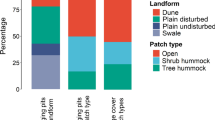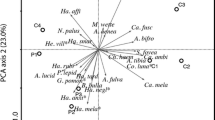Abstract
Burrowing birds, such as sand martins (Riparia riparia), are tightly bound to resource patches narrowly defined by soil penetrability, clay content, low incidence of parasites, and sufficient amount of aerial prey. Such habitat patches are limited both in number and quality, and their management is expected to affect not only the target flagship species, but also the non-target species represented by solitary ground-nesting aculeate hymenopterans utilizing the same habitat patches. The efficiency of sand martin habitat restoration at 23 localities was evaluated. Since most of the successful efforts resulted in a decrease of soil penetration resistance, whether the observed penetration resistance decrease had an effect on non-target aculeate hymenopterans utilizing vertical or near-vertical slopes was studied. To assess this, penetration resistance and soil granulometric characteristics were measured at 39 randomly selected vertical slopes, and the density of ground-nesting aculeate hymenopterans was evaluated. Ground-nesting aculeate hymenopterans were found to avoid slopes containing only soil strata with high penetration resistance, or with high gravel content. The burrow density in slopes with regular (bi)annual management was similar to the burrow density in slopes with medium to low penetrability but with less frequent management efforts. Removal of the hard-packed crust resulted in the return of both sand martins and aculeate hymenopterans in the respective slopes. Flagship bird species habitat management was found to support not only the the target burrowing bird, but also the non-target ground-nesting aculeate hymenopteran species.



Similar content being viewed by others
References
Alcock J (1975) Social interactions in the solitary wasp Cerceris simplex (Hymenoptera: Sphecidae). Behaviour 54:142–151
Alcock J (1980) Communal nesting in an Australian solitary wasp, Cerceris antipodes Smith (Hymenoptera, Sphecidae). J Austral Entomol Soc 19:223–228
Beneš J, Kepka J, Konvička M (2003) Limestone quarries as refuges for European xerophilous butterflies. Conserv Biol 17:1058–1069
Bogusch P, Straka J, Kment P (eds) (2007) Annotated checklist of the Aculeata (Hymenoptera) of the Czech Republic and Slovakia. Acta Entomol Mus Nat Pragae, Supplementum 11:1-300
Brockmann HJ (1979) Nest site selection in the great golden digger wasp, Sphex ichneumoneus L. (Sphecidae). Ecol Entomol 4:211–224
Cane JH (1991) Soils of ground-nesting bees (Hymenoptera: Apoidea): texture, moisture, cell depth and climate. J Kans Entomol Soc 64:406–413
Collins BD, Sitar N (2011) Stability of steep slopes in cemented sands. J Geotech Geoenviron Eng 137:43–51
Common M, Stagl S (2005) Ecological economics: an introduction. Cambridge University Press, Cambridge
Damigos D, Kaliampakos D (2003) Environmental economics and the mining industry: monetary benefits of an abandoned quarry rehabilitation in Greece. Environ Geol 44:356–362
Dvořák L, Bogusch P (2008) Žahadloví blanokřídlí (Hymenoptera: Aculeata) bývalé pískovny u Pamferovy Huti (západní Šumava). Silva Gabreta 14:149–162
Dynesius M, Nilsson C (1994) Fragmentation and flow regulation of river systems in the northern third of the world. Science 266:753–762
Elser JJ, Fagan WF, Denno RF, Dobberfuhl DR, Folarin A, Huberty A, Interlandi S, Kilham SS, McCauley E, Schulz KL, Siemann EH, Sterner RW (2000) Nutritional constraints in terrestrial and freshwater food webs. Nature 408:578–580
Evans HE, Hook AW (1982) Communal nesting in the digger wasp Cerceris australis (Hymenoptera: Sphecidae). Austral J Zool 30:557–568
Farkač J, Král D, Škorpík M (eds) (2005) Red list of threatened species in the Czech Republic. Invertebrates. AOPK ČR, Prague
Fellendorf M, Mohra C, Paxton RJ (2004) Devasting effects of river flooding to the ground-nesting bee, Andrena vaga (Hymenoptera: Andrenidae), and its associated fauna. J Insect Conserv 8:311–322
Francisca FM (2007) Evaluating the constrained modulus and collapsibility of loess from standard penetration test. Int J Geomech 7:307–310
Ghazoul J (2001) Effect of soil hardness on aggression in the solitary wasp Mellinus arvensis. Ecol Entomol 26:457–466
Girvetz EH (2010) Removing erosion control projects increases bank swallow (Riparia riparia) population viability modeled along the Sacramento River, California, USA. Biol Conserv 143:828–838
Heneberg P (2001) Size of sand grains as a significant factor affecting the nesting of bank swallows (Riparia riparia). Biologia 56:205–210
Heneberg P (2003) Soil particle composition affects the physical characteristics of Sand Martin Riparia riparia holes. Ibis 145:392–399
Heneberg P (2009) Soil penetrability as a key factor affecting the nesting of burrowing birds. Ecol Res 24:453–459
Hjertaas DG (1984) Colony site selection in Bank Swallows. M.Sc. Thesis, Univ. of Saskatchewan, Saskatoon
Kim J, Williams N, Kremen C (2006) Effects of cultivation and proximity to natural habitat on ground-nesting native bees in California sunflower fields. J Kans Entomol Soc 79:309–320
Laeser SR, Baxter CV, Fausch KD (2005) Riparian vegetation loss, stream channelization, and web-weaving spiders in northern Japan. Ecol Res 20:646–651
Lambeets K, Hendrickx F, Vanacker S, Van Looy K, Maelfait J-P, Bonte D (2008) Assemblage structure and conservation value of spiders and carabid beetles from restored lowland river banks. Biodivers Conserv 17:3133–3148
Lamotte M, Bruand A, Humbel FX, Herbillon AJ, Rieu M (1997) A hard sandy-loam soil from semi-arid Northern Cameroon: I. Fabric of the groundmass. Eur J Soil Sci 48:213–225
Lehner PN (1998) Handbook of ethological methods. Cambridge University Press, Cambridge
McCorquodale DB (1989) Soil softness, nest initiation and nest sharing in the wasp, Cerceris antipodes (Hymenoptera: Sphecidae). Ecol Entomol 14:191–196
Michener CD, Rettenmeyer CW (1956) The ethology of Andrena erythronii with comparative data on other species. Univ Kans Sci Bull 37:645–684
Moffatt KC, Crone EE, Holl KD, Schlorff RW, Garrison BA (2005) Importance of hydrologic and landscape heterogeneity for restoring Bank Swallow (Riparia riparia) colonies along the Sacramento River, California. Restor Ecol 13:391–402
Morato EF, Martins RP (2006) An overview of proximate factors affecting the nesting behavior of solitary wasps and bees (Hymenoptera: Aculeata) in preexisting cavities in wood. Neotrop Entomol 35:285–298
Nakano D, Akasaka T, Kohzu A, Nakamura F (2007) Food sources of Sand Martins Riparia riparia during their breeding season: insight from stable-isotope analysis. Bird Study 54:142–144
Polidori C, Casiraghi M, Di Lorenzo M, Valarani B, Andrietti F (2006) Philopatry, nest choice, and aggregation temporal-spatial change in the digger wasp Cerceris arenaria (Hymenoptera: Crabronidae). J Ethol 24:155–163
Polidori C, Boesi R, Pesarini C, Papadia C, Bevacqua S, Federici M, Andrietti F (2007) Temporal relationship between the prey spectrum and population structure of the weevil-hunting wasp Cerceris arenaria (Hymenoptera: Crabronidae). Zool Stud 46:83–91
Polidori C, Rubichi A, Barbieri V, Trombino L, Donegana M (2010) Floral resources and nesting requirements of the ground-nesting social bee, Lasioglossum malachurum (Hymenoptera: Halictidae), in a Mediterranean semiagricultural landscape. Psyche, article ID 851947, doi:10.1155/2010/851947
Potts SG, Willmer P (1997) Abiotic and biotic factors influencing nest-site selection by Halictus rubicundus, a ground-nesting halictine bee. Ecol Entomol 22:319–328
Potts SG, Willmer P (1998) Compact housing in built-up areas: spatial patterning of nests in aggregations of a ground-nesting bee. Ecol Entomol 23:427–432
Schlüter C (2002) Bienen und Grabwespen anthropogener Standorte im Landkreis Ammerland (Hymenoptera: Aculeata). Drosera 2002:133–156
Sieber O (1980) Kausale und funktionale Aspekte der Verteilung von Uferschwalbenbruten (Riparia riparia L.). Z Tierpsychol 52:19–56
Srba M, Heneberg P (2012) Nesting habitat segregation between closely related terricolous sphecid species (Hymenoptera:Spheciformes): key role of soil physical characteristics. J Insect Conserv, online first, doi 10.1007/s10841-011-9441-4
Wang Y-P, Siefferman L, Wang Y-J, Ding T-S, Chiou C-R, Shieh B-S, Hsu F-S, Yuan H-W (2009) Nest site restoration increases the breeding density of blue-tailed bee-eaters. Biol Conserv 142:1748–1753
Yuan H-W, Wang M-K, Chang W-L, Wang L-P, Chen Y-M, Chiou C-R (2006) Soil composition affects the nesting behavior of blue-tailed bee-eaters (Merops philippinus) on Kinmen Island. Ecol Res 21:510–512
Acknowledgments
I thank to Jiří Řehounek, Edvard Sequens, Olga Dvořáková, Václav Kovář, Karel Šimeček, and Petr Berka for sharing data regarding sand martin protection efforts at some of the referenced localities. This study was supported in part by the Ministry of the Environment of the Czech Republic. I thank Editor and the two anonymous referees for their helpful comments on the first version of this manuscript.
Author information
Authors and Affiliations
Corresponding author
Electronic supplementary material
Below is the link to the electronic supplementary material.
Rights and permissions
About this article
Cite this article
Heneberg, P. Flagship bird species habitat management supports the presence of ground-nesting aculeate hymenopterans. J Insect Conserv 16, 899–908 (2012). https://doi.org/10.1007/s10841-012-9477-0
Received:
Accepted:
Published:
Issue Date:
DOI: https://doi.org/10.1007/s10841-012-9477-0




